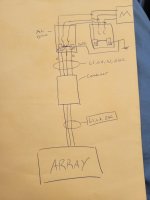sparkles97
Member
- Location
- Washington
Please excuse my messy drawing. I am trying to wrap my head around the requirements to satisfy 250.25 in the 2020 NEC. On a grid-tied microinverter solar system connected via supply side tap, 250.25 would have me treat the AC disconnect the same as a service as far as bonding requirements.
Question 1: Why bond the grounded conductor, earth, and EGCs in the AC disconnect when it is already done in the main panel already facilitating an effective ground fault path?
Question 2: Now that the grounded conductor, earth, and EGCs are bonded in the disconnect, the ground wire going back to the main panel would now be our GEC and subject to the requirements of a GEC?
Question 3: If the combiner box doesn't need a neutral for 120v control voltage, do we still need a neutral pulled to the AC disconnect to bond neutral and ground again?
Question 1: Why bond the grounded conductor, earth, and EGCs in the AC disconnect when it is already done in the main panel already facilitating an effective ground fault path?
Question 2: Now that the grounded conductor, earth, and EGCs are bonded in the disconnect, the ground wire going back to the main panel would now be our GEC and subject to the requirements of a GEC?
Question 3: If the combiner box doesn't need a neutral for 120v control voltage, do we still need a neutral pulled to the AC disconnect to bond neutral and ground again?


